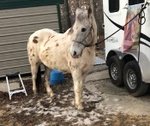

With Spring comes a myriad of changes. The farm comes alive with floating hair, flowering buds, new sprouts, young leaves, awakening bugs, and worms. Big, little, microscopic, encysted, larval worms invade the fields, woods, and horses. I am blessed with a multitude. I have the night-crawlers. I have the smaller “composters”. I also have the microscopic posing a threat to the horses.
The variety of microscopic worms or parasites calling the Upper Cumberland home astounds me as they live on the skin, in the hair, under the skin, in the circulatory system, in the digestive system and in the respiratory system. If left unchecked, according to University of Tennessee research, parasites may cause a number of negative health issues presenting in unthrifty coat health, lower weights, dull eyes, joint pain, fatigue, colic, open sores and more.
Both the American Association of Equine Practitioners, AAEP, and the University of Tennessee Center of Veterinary Medicine, UTCVM, professionals recommend abandoning the practice of rotational deworming on a six week basis with a variety of anthelmintics in favor of a strategic, personalized deworming program for each horse. Exceptions exist for those who have high stocking rates or small farms. According to test results from the past several years, large strongyle presents less commonly than its counterpart, the small strongyle. Tapeworm infestations are on the rise. In general, worms are becoming resistant to anthelmintics, the commercial wormers.
As part of this personalized practice, the UT veterinarians recommend obtaining a fecal egg count test, FEC, six to twelve weeks after using a commercial wormer to determine the wormer’s effectiveness. The results are classified into three categories as Low Shedding, Medium Shedding and High Shedding. UT developed a worming chart based on the results of the FEC testing. Ironically, the AAEP found 20% of horses in a field carried the highest worm load and created most of the pasture burden. Testing for worms produces more accurate results in early Spring and Fall as parasitic activity is temperature dependent. (The chart shown is courtesy of UTCVM.)
Along with FEC testing, practicing good pasture management with waste removal and rotational grazing goes a long way to limiting parasitic pasture burden. Suggestions for small farms include mitigating stocking rates to one horse per acre and composting manure unless complete removal is possible. Some veterinarians recommend rotating equids, horse species, with ruminants, livestock. A few homesteaders in the area graze the livestock with their horses or allow the chickens or guinea hens to free range claiming better health and lower parasitic infestation rates in all the animals.
The UTCVM’s big picture parasitic reduction program includes the following question, “Is strategic deworming worth the extra effort?” For the veterinarians, the answer is yes as they ask the local horse owners to consider the latest research which discovered the following: 1. Commercial wormer resistance problems are growing. 2. Horses are being over-treated with anthelmintics. 3. Less is more meaning less treatment achieves better results. 4. Deworming is not necessary during very cold or very hot times of the year. 5. Practicing good pasture management and a personalized deworming program results in better horse health overall.
For my horses, I will do FEC testing, clean the loafing areas, sterilize run-in sheds and compost piles which is always shareable. As far as the worms, I will keep the “composters”. My husband loves the night crawlers. Everyone dislike the microscopic. Personally, I could do without the hair. For more information, please visit vetmed.tennessee.edu or the aaep.org.